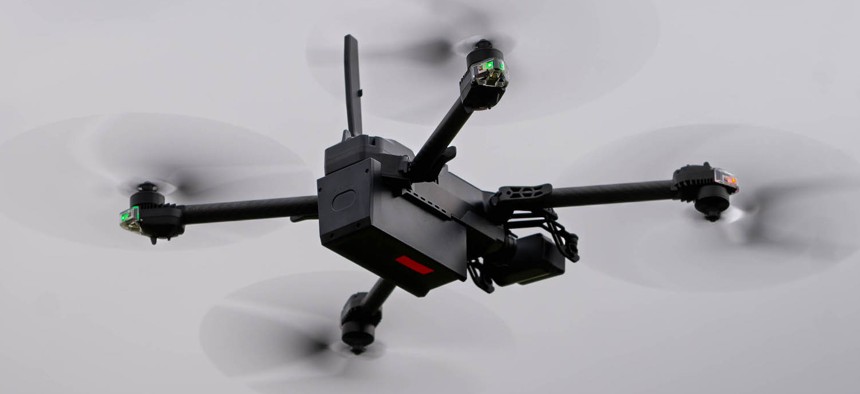
A Skydio X2d quadcopter drone on March 8, 2023, in Belleville, Illinois. U.S. Air Force / Airman 1st Class Madeline Baisey
Army moves ahead on Ukraine-style bomber drones
Two firms will show off gear that enables UAVs to drop a range of standard Army munitions.
The U.S. Army has picked companies to demonstrate gear for arming small commercial drones, as Ukrainian and Russian forces are doing to dramatic effect in Ukraine.
Within eight to 12 months, two companies will demonstrate payload mechanisms for dropping a selection of munitions that troops would have readily available, such as 40mm or 60mm grenades, said Dan Hilty, portfolio manager for the Army Applications Laboratory. The mechanisms must also allow soldiers to safely attach and detach the munitions, Hilty said.
The companies, which Hilty declined to identify, are using drones from the Pentagon’s Blue UAS list, a roster of commercial drones cleared for military use.
Both Ukraine and Russia widely use commercial drones that have been rigged to drop grenades and mortars. Triggering the drop mechanism can be done by using a drone’s existing controls, like putting a light-sensitive switch in front of its camera flash, as Defense One saw at a drone operator training school in Kyiv last year.
Setting up the weapons, however, can take a dose of courage. One experienced Ukrainian operator told Defense One last year that he took on the role because he wasn’t afraid to make the necessary modifications to drone-dropped munitions.
A further two companies are developing the capability to equip soldiers with small drones with more advanced munitions, Hilty said. One of the two is even demonstrating a drone weighing less than 55 pounds that can fire a precision guided missile.
Similar bomb-dropping drones are already in use among units playing the Army’s opponents at the National Training Center and Joint Readiness Training Center, the units’ commanders previously told Defense One.
Army Applications Laboratory is also researching drones that could be turned into loitering munitions, similar to how Ukraine and Russia have turned hobbyist racing drones into DIY suicide drones.
The research comes amid an Army push to incorporate lethal drones into Army infantry units. In August, the Army announced the Low Altitude Stalking and Strike Ordnance project, or LASSO, which seeks to provide soldiers with portable loitering munitions. While the Army did not announce which company will provide the munitions, they expect to field the weapon across infantry brigade combat teams in 2024.
Expense is one consideration, however. Existing loitering munitions used by the U.S. Army’s would be among an individual soldier’s most expensive piece of kit. AeroEnvironment’s Switchblade 300, for example, costs $6,000.
Ukraine’s bomb-dropping commercial drones or bomb-equipped racing drones similar in concept to those being tested by Army Applications Laboratory, cost a fraction of that. Ukrainian drone companies produce racing drones equipped as loitering munitions for as little as $200.
Cheaper drones also means that the average soldier would get more hands-on training, Scott Boston, a senior defense analyst at the RAND Corporation, previously told Defense One.
